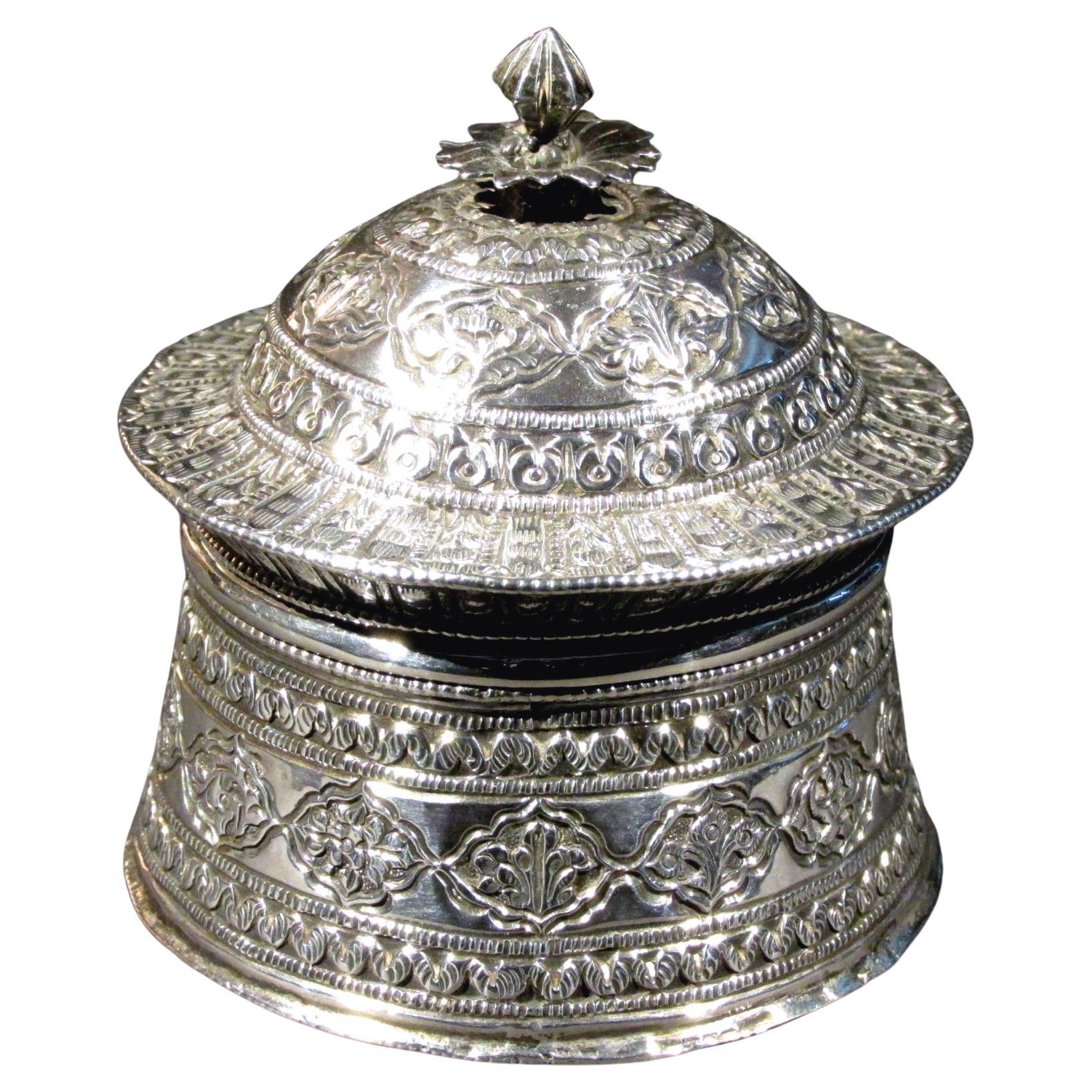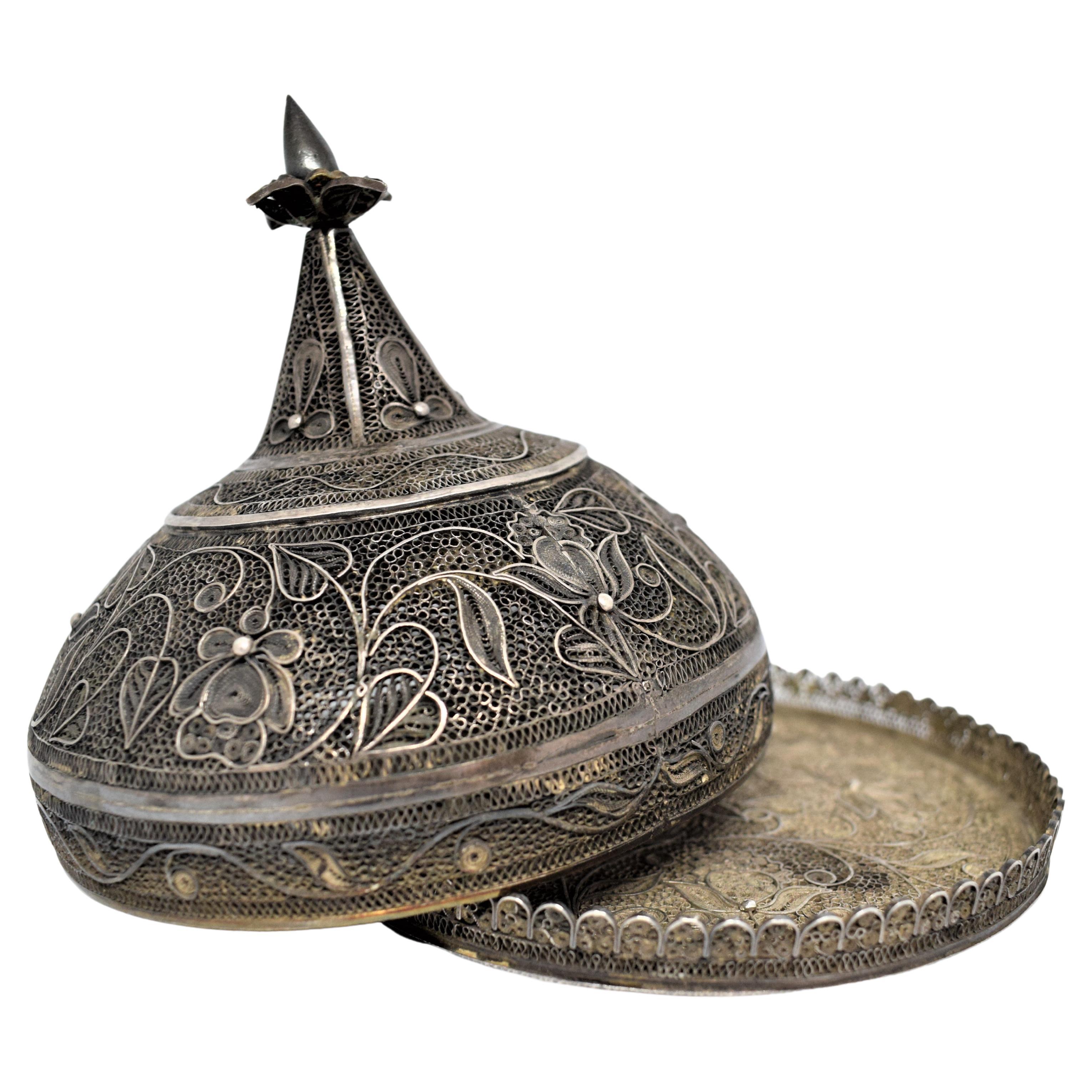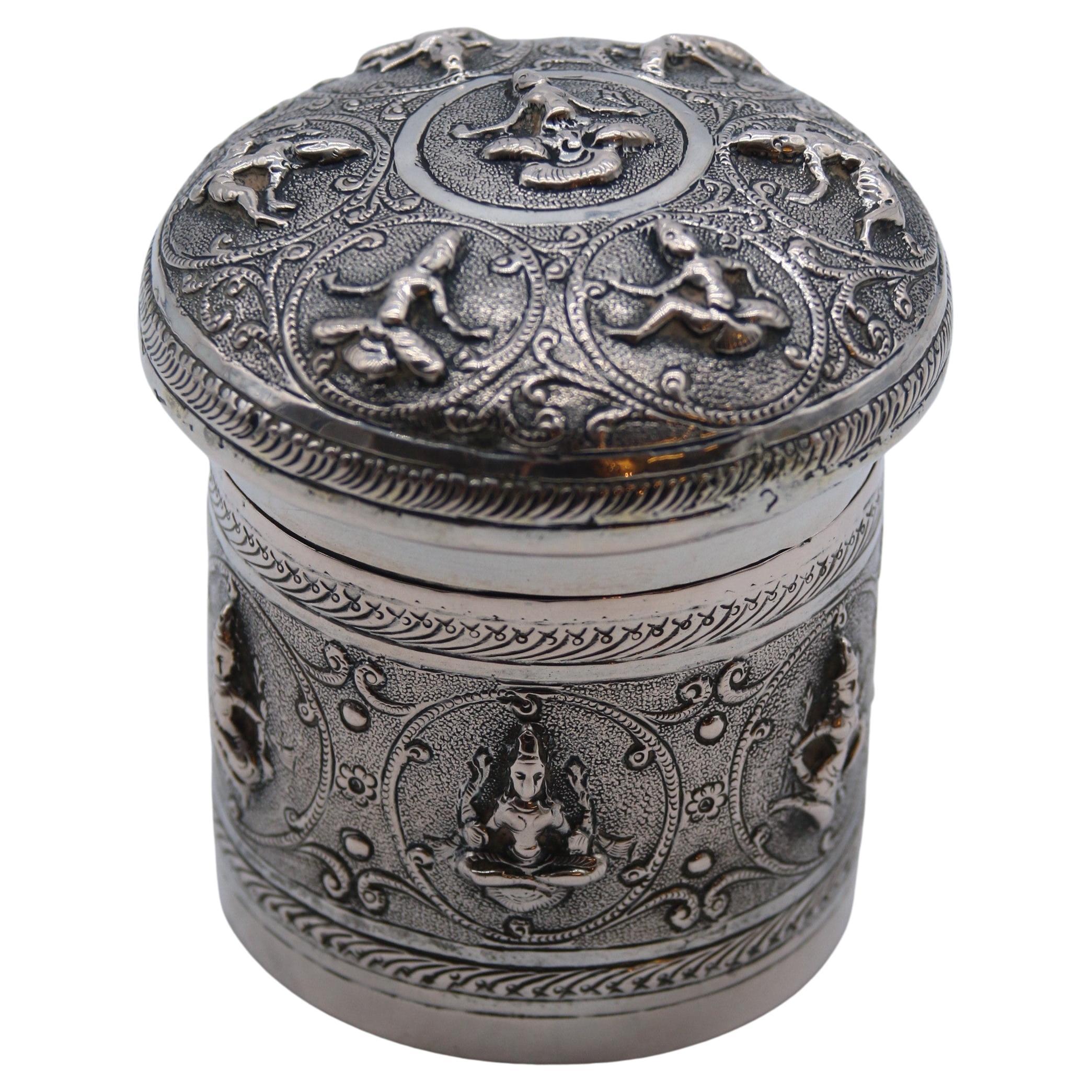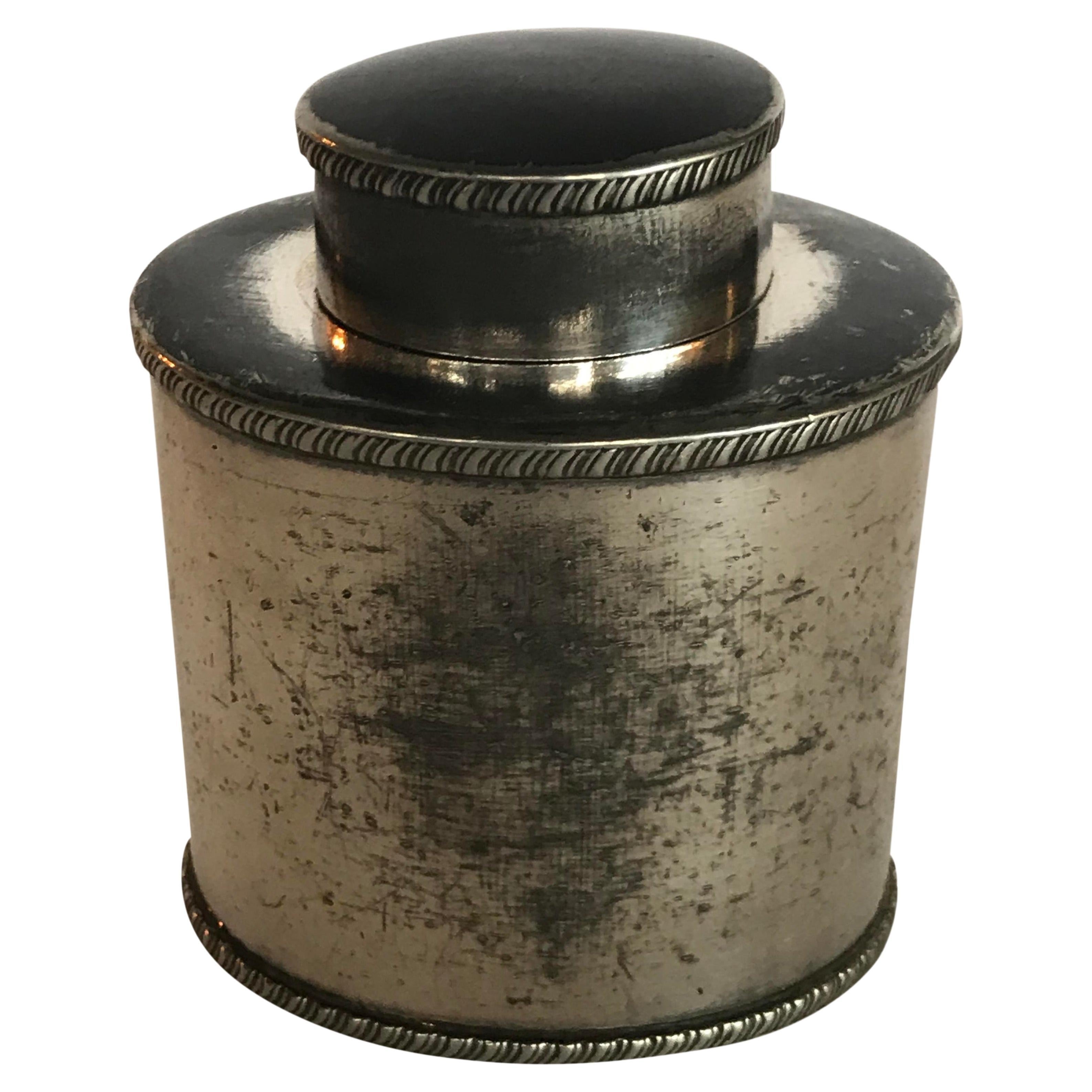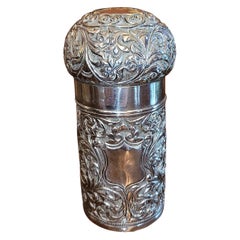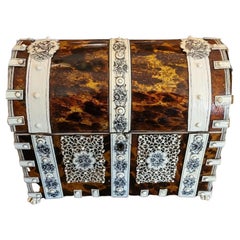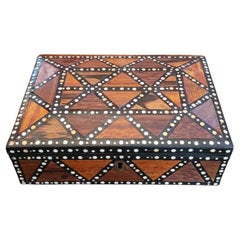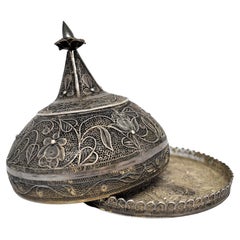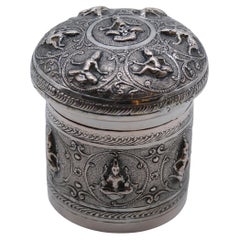Items Similar to 19th Century Anglo-Indian Spice or Tea Caddy with Silver Mounts
Want more images or videos?
Request additional images or videos from the seller
1 of 10
19th Century Anglo-Indian Spice or Tea Caddy with Silver Mounts
$650
£488.63
€566.48
CA$907.50
A$1,016.45
CHF 528.89
MX$12,344.71
NOK 6,705.01
SEK 6,326.68
DKK 4,226.71
Shipping
Retrieving quote...The 1stDibs Promise:
Authenticity Guarantee,
Money-Back Guarantee,
24-Hour Cancellation
About the Item
PRESENTING A GORGEOUS 19C Anglo Indian Rosewood Caddy with Silver Mounts.
Really nice and unusual, 19th Century Anglo-Indian Spice or Tea Caddy, from circa 1890.
Made of solid rosewood with solid/sterling silver mounts and bands on base and lid.
The lid has 3 silver studs and a central silver large clasp which connect to a wooden finial underneath.
The lid is the banded with silver repousse work.
The lid fits snuggly into the base, to make it air-tight, to keep the contents fresh.
The base is solid turned rosewood with silver repousse banding.
The chain is silver but a later replacement, but would be similar to the original.
We have never seen another Caddy like this!
It could have held spices, tea or tobacco.
- Dimensions:Height: 6.5 in (16.51 cm)Width: 3 in (7.62 cm)Depth: 3 in (7.62 cm)
- Style:Anglo Raj (Of the Period)
- Materials and Techniques:
- Place of Origin:
- Period:
- Date of Manufacture:1890
- Condition:Wear consistent with age and use. The Caddy is in great original condition. All original, save the chain which is a later replacement.
- Seller Location:Dallas, TX
- Reference Number:1stDibs: LU3978112027933
About the Seller
4.9
Vetted Professional Seller
Every seller passes strict standards for authenticity and reliability
Established in 2015
1stDibs seller since 2018
390 sales on 1stDibs
Typical response time: 2 hours
- ShippingRetrieving quote...Shipping from: Dallas, TX
- Return Policy
Authenticity Guarantee
In the unlikely event there’s an issue with an item’s authenticity, contact us within 1 year for a full refund. DetailsMoney-Back Guarantee
If your item is not as described, is damaged in transit, or does not arrive, contact us within 7 days for a full refund. Details24-Hour Cancellation
You have a 24-hour grace period in which to reconsider your purchase, with no questions asked.Vetted Professional Sellers
Our world-class sellers must adhere to strict standards for service and quality, maintaining the integrity of our listings.Price-Match Guarantee
If you find that a seller listed the same item for a lower price elsewhere, we’ll match it.Trusted Global Delivery
Our best-in-class carrier network provides specialized shipping options worldwide, including custom delivery.More From This Seller
View All19C Anglo Indian Silver Perfume Bottle Case
Located in Dallas, TX
19C Anglo Indian solid silver perfume bottle case.
Lovely 19th century Anglo-Indian solid silver perfume bottle case with profuse repousse work.
Not hallmarked because it was m...
Category
Antique Late 19th Century Indian Anglo Raj Sterling Silver
Materials
Sterling Silver
19C Anglo Indian Vizagapatam Bone and Shell Domed Stationery Box
Located in Dallas, TX
PRESENTING A LOVELY 19C Anglo Indian Vizagapatam Bone and Shell Domed Stationery Box – ‘Alice’s Box’.
Made in Vizagapatam, India, circa 1860-80.
We call this one: “Alice’s Box”! It has lived ‘a hard, well used and traveled life’, as is evident from the number of losses and repairs, as is obvious from the photos, especially to the faux ivory panels and bands to the top. The bonus to the loss of the frieze panels to the dome has a ‘bonus’, however, as their loss has revealed the most GORGEOUS faux blonde tortoiseshell underneath!
The box is dome/casket shaped.
The top has 3 bands, with the center one being the original. The 2 side bands are later ivorine.
The faux ivory and hand-painted medallions on the domed lid, have been saved and they depict Hindu Gods, Vishnu and Shiva.
The front and side panels are still in pretty good shape and are decorated with lac ink (indelible ink made from crushed beetles) depicting lovely floral designs.
The domed lid open to reveal a series of open compartments for envelopes, writing paper etc. and one lidded panel for stamps.
Inside the box are 2 paper labels: one probably being the original item ticket and the other with:
” Alice’s address is 272 Ashworth Ave, Toronto 4, Ontario”.
Probably, the original owner? Hence, we call it ‘Alice’s Box’.
What a journey/life this box has had!
Made in India, made its way to Canada, back to Ireland and then to Texas!
This is why, WE LOVE ANTIQUES...
Category
Antique 19th Century Indian Anglo-Indian Decorative Boxes
Materials
Bone, Shell, Sandalwood
19C Anglo Ceylonese Specimen Wood Trinket Box
Located in Dallas, TX
PRESENTING A BEAUTIFUL and RARE 19C Anglo Ceylonese Specimen Wood Trinket Box.
Made in ‘Galle’, Ceylon (now Sri Lanka) circa 1860-80.
Made for the ex...
Category
Antique 19th Century Sri Lankan Anglo-Indian Jewelry Boxes
Materials
Bone, Hardwood, Ebony, Sandalwood
Set of 6 Mindanao Brass Silver Betel Boxes, Philippines
Located in Dallas, TX
Presenting an amazing set of 6 Mindanao brass silver betel boxes, Philippines.
Betel chewing was prevalent in the southern Philippines as in much o...
Category
Antique Late 19th Century Philippine Islamic Tea Caddies
Materials
Silver, Brass, Copper
19C Anglo Indian Vizigapatam Stamp Box
Located in Dallas, TX
Presenting an absolutely gorgeous and very rare 19C Anglo Indian Vizigapatam stamp box.
Made in Colonial India (the Time of the Raj) circa 1860.
Prob...
Category
Antique Mid-19th Century Indian Anglo-Indian Decorative Boxes
Materials
Bone, Shell
19C Irish Coromandel Wood Campaign Decanter Box
Located in Dallas, TX
PRESENTING A STUNNING 19C Irish Coromandel Wood Campaign Decanter Box.
STUNNING mid-Victorian Decanter box from circa 1860-1880.
Made in Dublin...
Category
Antique 19th Century Irish Campaign Decorative Boxes
Materials
Crystal, Silver, Brass
$4,250 / set
You May Also Like
A Mid 19th Century Mughal Style Silver Betel Box, Northern India
Located in Ottawa, Ontario
Intended to hold paan or betel, the seamed cylindrical body flaring downward towards the base, the domed lid showing a lotus-bud final over a flattened and canted rim, both decorated...
Category
Antique Mid-19th Century Indian Islamic Tobacco Accessories
Materials
Silver
Antique Moroccan Silver Plated Tea Caddy Footed Candy Box
Located in North Hollywood, CA
1920s Antique Moroccan Silver Plated Footed Tea Caddy with hinged lid.
This authentic Moroccan brass silver plated box has a beautiful etched geometri...
Category
Early 20th Century Moroccan Moorish Tea Caddies
Materials
Silver Plate, Brass
Kashmiri Silver Betel Nut Box, Khaas Daan, Late 19th Century
Located in Islamabad, PK
Kashmiri silver betel nut box, Khaas Daan, late 19th century
Betel-chewing is a leisure pastime practiced since ancient times in many parts of ...
Category
Antique Late 19th Century Indian Anglo Raj Serving Pieces
Materials
Silver
Indian Raj period silver repousse decorated lidded container, circa 1900
Located in Central England, GB
A fine Indian silver lidded container is unmarked but tested. It is finely decorated with raised and chased dancing figures which are finely detailed with hand engraving and separate...
Category
Early 20th Century Indian Anglo Raj Metalwork
Materials
Silver
Mid 19th Century Silver Plate Tea Caddy Container
Located in Charlottesville, VA
Silver plate tea caddy. A beautiful English traditional accent. It’s well worn with lots of charm.
Category
Antique Mid-19th Century British Tea Caddies
Materials
Silver Plate
Grish Chunder Dutt 1880s Indian Silver Tea Caddy
By Grish Chunder Dutt
Located in Jesmond, Newcastle Upon Tyne
An exceptional, fine and impressive antique Indian silver tea caddy, an addition to our silver teaware collection.
This exceptional antiqu...
Category
Antique 1880s Indian Tea Caddies
Materials
Silver
More Ways To Browse
Boxes With Clasp
Silver Box India
Wooden Finials
Antique Spices
India Rosewood
Silver Repousse Box
India Repousse
Antique Sterling Silver Tea Caddy
Large Tea Caddy
Wooden Tea Box
Antique Spice Box
Spice Boxes
19th Century Rosewood Tea Caddy
Silver Spice Box
Antique Wooden Tea Caddies Tea Caddies
Sterling Spice Box
Tobacco Caddy
Repousse Silver Tea Caddy
